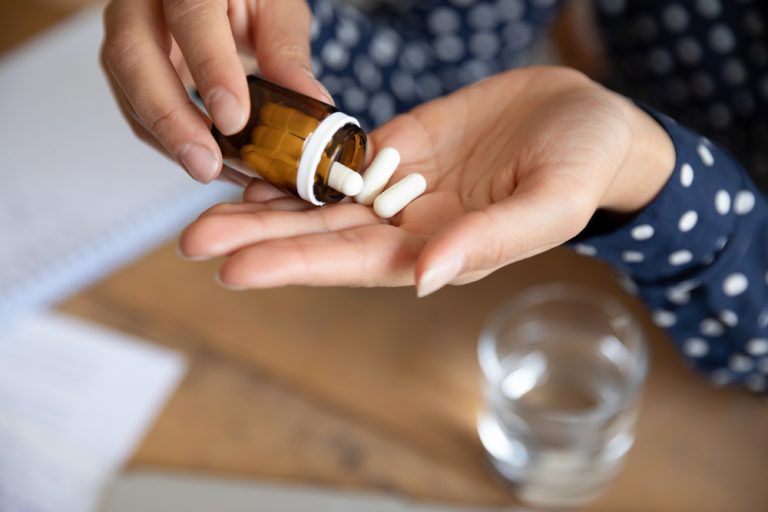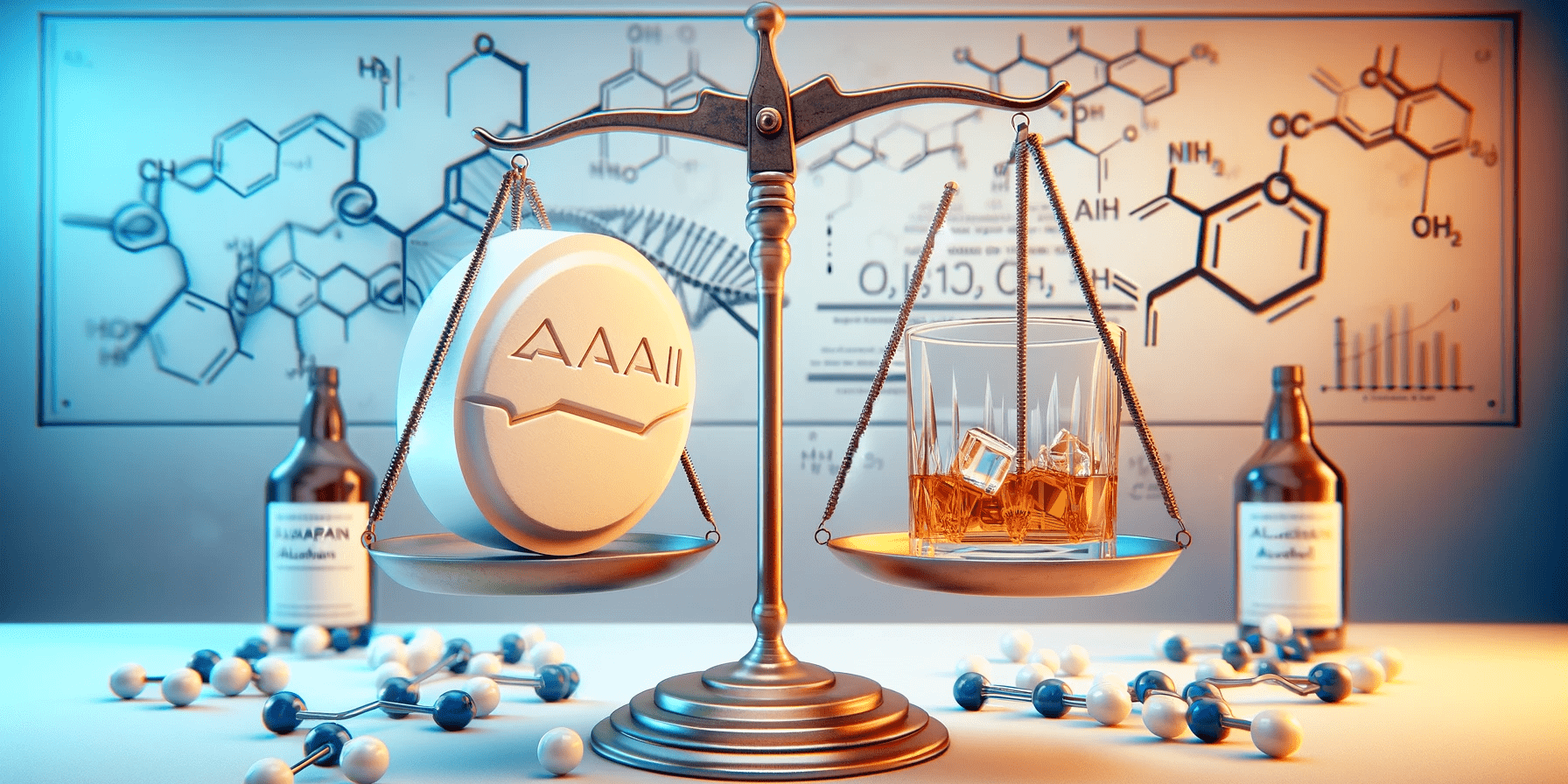Prescribed codeine, such as Zapain, is a painkiller that when mixed with alcohol can lead to serious situations. Zapain is a codeine based medication, and mixing it with an alcoholic beverage can significantly increase health risks, requiring extra caution.
Mixing Zapain with alcohol can also increase the risk of allergic reactions, such as skin rash and urticaria. Many people mix codeine with alcohol for enhanced euphoric effects and self-medication motivations, but this combination can be dangerous. With pain management a big issue for many, it’s important to know the risks of taking prescription drugs like Zapain with alcohol. Here’s the lowdown on why and what to do.
Zapain, a codeine based medication normally containing 30 mg of codeine and 500mg paracetamol per tablet, should not be mixed with alcohol.
Combining the two can lead to heightened side effects and increase the risk of liver damage and overdose.
Consulting healthcare providers before consuming alcohol with Zapain is crucial.
What is Zapain?
Zapain is a medication containing two main ingredients: codeine phosphate and paracetamol. It’s used to relieve mild to moderate and severe pain. Codeine is a member of a group of medicines called opiates, which act on the central nervous system to reduce pain signals to the brain.
Codeine is derived from the opium poppy, a natural source of several narcotic substances used in medicine. Paracetamol is a weaker pain reliever that enhances the effect of codeine. Codeine is also used as a cough suppressant. The combination of codeine and paracetamol in Zapain is effective for pain control, especially for moderate to severe pain.
Side Effects of Zapain
Zapain (paracetamol and codeine) is good for pain relief but can have side effects. Common side effects are drowsiness, dizziness, nausea, vomiting, constipation, headaches, fatigue, and confusion. These will affect daily activities and overall well-being, so use Zapain as directed.
More serious side effects can occur, like respiratory depression, liver damage, kidney damage, seizures and coma. Respiratory depression is a big risk when taking codeine with alcohol as both can slow down breathing. Follow the prescribed dosage and consult your doctor if you experience any side effects. Monitor your health and be aware of these risks to prevent severe complications.
The Dangers of Mixing Zapain with Alcohol

How Zapain works:
Codeine: Binds to opioid receptors in the brain, altering pain perception.
Paracetamol: Inhibits the production of prostaglandins, reducing pain and fever.
Effects of Alcohol on the Body
Alcohol, a central nervous system depressant, can have a range of effects on the body, including:
Impaired brain function
Slowed down reaction time
Reduced inhibitions
When alcohol is consumed, it’s metabolised by the liver. However, excessive consumption can overwhelm the liver, leading to increased blood alcohol levels and intoxication.
Interaction of codeine and alcohol
Combining Zapain with alcohol can result in the following:
Increased drowsiness and sedation
Heightened risk of liver damage
Greater chance of overdose
The drug’s effects can be intensified when codeine and alcohol are combined, increasing the risk of dependency and serious health complications. This combination can also alter the timing and intensity of their effects due to changes in peak plasma concentrations, making the interaction even more dangerous.
Also, combining Zapain with alcohol can increase the risk of codeine addiction. Recognize the signs of addiction early for timely intervention. Additionally, the combination can exacerbate alcohol addiction, necessitating specialized rehabilitation programs to address both alcohol and codeine addiction effectively.
Short-Term Effects of Mixing Zapain and Alcohol
Mixing Zapain and alcohol can lead to severe short-term effects, including:
Excessive sedation: The combination of codeine and alcohol can cause extreme drowsiness, making it difficult to stay awake or alert.
Impaired motor skills: The central nervous system depressant effects of both substances can impair coordination, balance, and reaction time, increasing the risk of accidents and injuries.
Cognitive dysfunction: Mixing Zapain and alcohol can affect concentration, memory, and decision-making abilities, leading to confusion, disorientation, and poor judgment.
Gastrointestinal issues: The combination can cause stomach pain, nausea, vomiting, and diarrhea, which can lead to dehydration and electrolyte imbalances.
Respiratory depression: The risk of respiratory depression increases when mixing Zapain and alcohol, which can lead to slowed or stopped breathing, and even death.
Long-Term Effects of Mixing Zapain and Alcohol
Chronic misuse of Zapain and alcohol can lead to severe long-term effects, including:
Addiction: The combination of codeine and alcohol can lead to physical dependence and addiction, making it challenging to stop using without professional help.
Liver damage: The liver can become damaged due to the excessive strain of processing both substances, leading to liver disease and potentially life-threatening complications.
Gastrointestinal problems: Chronic use can cause stomach ulcers, inflammation, and scarring, leading to chronic pain, digestive issues, and malnutrition.
Mental health issues: The combination can contribute to the development of a mental health disorder, such as depression, anxiety, or mood swings.
Increased risk of overdose: The risk of overdose increases with chronic use, which can lead to respiratory failure, coma, or death.
Medical view on Zapain and Alcohol

The NHS and other medical bodies uniformly advise against the consumption of alcohol while taking any prescription-only painkiller, including Zapain. This guidance is due to the increased likelihood of combined adverse side effects. Patients can contact the medical information department for any enquiries. These guidelines are especially important for patients suffering from chronic pain or other conditions requiring codeine.
Risks of taking prescription painkillers with alcohol
- Enhanced sedative effect: Both Zapain and alcohol can cause drowsiness on their own, and Zapain is part of a group of opioid painkillers known for their addictive potential and risk of dependence. When taken together, this effect is significantly amplified. Codeine and alcohol abuse is a growing concern, as combining these substances for recreational purposes can lead to severe side effects and health risks.
- Liver toxicity: Both substances are metabolized by the liver, and taking them together can put additional strain on this organ, leading to potential damage.
- Overdose: The sedative effects of both can lead to respiratory depression, a dangerous condition where breathing becomes inadequate.
Personal Health Considerations When Using Zapain
The use of Zapain requires careful consideration of one’s health, particularly about addiction and liver health. If you have taken a codeine-based medication earlier in the day, you should be especially cautious about consuming alcohol due to lingering effects and increased risk.
Addiction and Respiratory Depression Risks with Zapain
Zapain has the potential for addiction if misused. Drug addiction is a serious medical condition that can result from prolonged misuse of codeine and alcohol, leading to both psychological and physical dependence. It’s essential to follow the prescribed dosage and duration and to be aware of the signs of addiction, such as:
Feeling restless or irritable when not taking the medication
Increased tolerance to the drug’s effects
A preoccupation with obtaining and using the drug
Liver Health and Implications of Mixing with Alcohol
The liver is crucial for metabolising both Zapain and alcohol. Avoid drinking alcohol while taking Zapain, as excessive use of either, especially in combination, can lead to liver damage, which may manifest as:
Jaundice
Abdominal pain
Elevated liver enzymes
For those concerned with addiction, the Rehab Today website provides valuable resources and warning signs to look out for.
Managing Moderate Pain with Zapain
Zapain is a prescription medication that contains codeine and paracetamol, making it an effective treatment for moderate pain. When used as directed, Zapain can help alleviate pain and discomfort, allowing individuals to manage their daily activities with ease. However, it’s essential to follow the prescribed dosage and consult with a healthcare professional to ensure safe and effective use.
To manage moderate pain with Zapain, it’s crucial to:
Take the medication as directed by your healthcare provider.
Follow the recommended dosage and frequency.
Monitor your pain levels and adjust your dosage accordingly.
Combine Zapain with other pain management techniques, such as physical therapy or relaxation exercises.
Regularly review your treatment plan with your healthcare provider to ensure optimal pain management.
By adhering to these guidelines, you can effectively manage moderate pain while minimising the risk of side effects and complications.
How Zapain works and Alcohol’s effect
Zapain’s codeine component is metabolized into morphine by the liver, where it then binds to opioid receptors in the brain. This binding action results in pain relief but also produces a feeling of euphoria, which can be addictive. The presence of alcohol can accelerate these effects, leading to an increased risk of dependency. For a visual explanation of how Zapain interacts within the body, watch this Remedy Reviews on Zapain.
When ending treatment with Zapain, it is crucial to reduce the dose gradually to minimize withdrawal symptoms. Gradually tapering the dose helps manage symptoms such as hyperalgesia and reduces the risk of drug dependence. Potential withdrawal symptoms associated with stopping Zapain, particularly due to codeine dependence, can include nausea, sweating, and irritability.
How Alcohol Alters Brain Chemicals
Alcohol affects neurotransmitters in the brain, notably gamma-aminobutyric acid (GABA), which slows down brain activity. It also increases the release of dopamine, another neurotransmitter associated with the brain’s reward system. This combination with Zapain’s effects on the brain can lead to complex interactions that heighten the risk of adverse reactions.
Understanding these mechanisms is vital. For a more comprehensive explanation of the development of addiction and the neurological pathways involved, seeking out educational videos on the subject can be incredibly helpful.
Patient Experiences and Case Studies
Personal accounts and clinical studies often shed light on the real-world implications of mixing medications like Zapain with alcohol.
Real-life Examples of Zapain and Alcohol Interactions
Several case studies have highlighted the dangers of mixing alcohol with Zapain. Patients have reported increased sedation levels, with some experiencing dangerous respiratory depression. These reports underscore the need for heightened awareness and adherence to medical advice.
Results
Results of mixing alcohol with Zapain may vary but the common thread is increased risk of adverse effects such as:
Slow or difficult breathing
Unconsciousness
Long-term liver damage
For those in recovery or wanting to know what to expect after rehab, PCP has articles on what to expect after drug rehab. The Recovery Village Columbus has also a video on codeine and alcohol risks which you can watch here:
Recovery, Rehabilitation, and Withdrawal Symptoms from Addiction
The path to recovery from addiction, particularly involving substances like Zapain and alcohol, is multifaceted and often requires a comprehensive treatment plan. Alcohol addiction, when combined with codeine, poses serious health risks and necessitates specialized rehabilitation programs to address both types of addiction effectively.
Resources and Support for Recovery
Effective recovery programs offer a combination of medical treatment, psychological support, and lifestyle changes. It’s important to approach recovery holistically, addressing both the physical and psychological components of addiction
Making Informed Choices
The decisions we make about our health can have profound effects on our well-being. When it comes to medications like Zapain and substances like alcohol, it’s essential to be informed and cautious.
Considerations for Safe Use:
Always follow the prescription guidelines.
Avoid alcohol while taking Zapain.
Consult with a healthcare provider before making any changes to your medication regimen.
For additional support and guidance on prioritising recovery and transforming your life post-addiction, Rehab Today provides valuable resources.
Safety Precautions When Using Zapain
To minimise the risks associated with Zapain, it is essential to follow these safety precautions:
What to Avoid While Taking Zapain
Avoid mixing Zapain with other central nervous system depressants, such as benzodiazepines, barbiturates, or other opioids.
Do not drink alcohol while taking Zapain, as it can increase the risk of adverse effects.
Avoid taking Zapain with other medications that can interact with codeine, such as antidepressants, antihistamines, or muscle relaxants.
Do not take Zapain if you have a history of substance abuse, addiction, or mental health disorders.
Foods to Avoid
Avoid consuming grapefruit or grapefruit juice while taking Zapain, as it can increase the risk of adverse effects.
Do not eat foods high in tyramine, such as aged cheese, wine, or fermented meats, as it can interact with codeine.
Why People Mix Codeine and Alcohol
Mixing codeine and alcohol is a practice observed among various individuals, often driven by the desire to enhance the euphoric effects of both substances.
Combining codeine with other substances, such as in recreational drinks like Lean or Sizzurp, is particularly dangerous and has become a cultural trend in some circles, but it greatly increases the risk of serious health complications. The dangers of mixing codeine with alcohol include heightened sedation, respiratory depression, and a much greater risk of overdose.
Some people may turn to this combination to self-medicate for physical or emotional pain, seeking a temporary escape from their discomfort.
Unfortunately, a lack of awareness about the potential risks and dangers associated with this combination can also lead to its misuse.
The combination of codeine and alcohol can create a synergistic effect, intensifying the overall impact on the body and mind. This can result in excessive sedation, impaired motor skills, cognitive dysfunction, and gastrointestinal issues. Moreover, the risk of addiction, overdose, and even death is significantly heightened when these substances are used together.
It’s crucial to understand that the pursuit of enhanced euphoria comes with severe consequences, making it essential to avoid mixing codeine and alcohol.
Mental Health and Zapain Use
Zapain use can have a profound impact on mental health, particularly when combined with alcohol. The combination of codeine and alcohol can lead to mood swings, anxiety, and depression. Mood swings may occur due to the disruption of neurotransmitters in the brain, causing emotional instability. Anxiety is another significant concern, as the combined use of codeine and alcohol can heighten feelings of unease and nervousness.
Depression can also result from the interaction between codeine and alcohol, leading to feelings of sadness, hopelessness, and despair. Prolonged and repeated use of Zapain and alcohol can potentially lead to the cumulative deterioration of mental health over time. Individuals with a predisposition to mental health conditions may find that the combination exacerbates their symptoms. It is essential to seek medical attention if you experience any adverse effects on your mental health while using Zapain.
Forms of Zapain Abuse
Zapain abuse can manifest in various forms, each carrying serious health risks. One common form of abuse is taking more than the prescribed dose. Exceeding the recommended dosage can lead to severe consequences, including overdose and respiratory depression. Another form of abuse is taking Zapain for longer than intended. Prolonged use can result in physical dependence and addiction, making it challenging to stop without professional help.
Using Zapain for non-medical purposes, such as recreational use or self-medicating for physical or emotional pain, is another dangerous form of abuse. This behavior can quickly lead to addiction and other serious health risks. Additionally, mixing Zapain with other substances, including alcohol, can have severe consequences, such as increased risk of overdose and death.
It is crucial to use Zapain only as directed by a healthcare professional and to be aware of the potential risks and dangers associated with its use. If you or a loved one is struggling with Zapain addiction, seek help immediately to prevent further harm and ensure a path to recovery.
Symptoms of Overdose and Emergency Response
In the event of an overdose, it’s essential to recognize the symptoms and respond promptly. Overdose symptoms may include:
Extreme drowsiness or loss of consciousness.
Slow or stopped breathing.
Confusion or disorientation.
Seizures or convulsions.
Low blood pressure.
If you suspect an overdose, call emergency services immediately. While waiting for help to arrive:
Try to keep the person awake and calm.
Loosen tight clothing and remove any constrictive items.
Turn the person onto their side to prevent choking.
Do not attempt to induce vomiting or give the person anything to drink.
Remember, immediate medical attention is crucial in the event of an overdose. If you or someone you know is struggling with codeine addiction or alcohol abuse, seek help from a healthcare professional or a reputable treatment centre. Recognising the signs early and taking swift action can save lives and prevent long-term health complications.
Frequently Asked Questions
What is the safe amount of alcohol with Zapain?
There is no safe amount of alcohol to consume with Zapain due to the increased risk of side effects and potential for liver damage.
Can you drink alcohol after taking Zapain?
It’s recommended to avoid alcohol during treatment with Zapain to prevent any adverse reactions or increased side effects.
What are the symptoms of Zapain and alcohol overdose?
Symptoms can include extreme drowsiness, confusion, difficulty breathing, and unresponsiveness. If you suspect an overdose, seek medical attention immediately.
Please remember that while this article provides information, it is not a substitute for professional medical advice. Always consult with a healthcare provider regarding any questions or concerns about medications and substance use
RehabToday by PCP - Get help with your addiction to alcohol drugs gaming gambling codependency
Author
-
Dr Otulana is PCP’s longest-serving doctor. He is an experienced Physician with Specialist Interest in Substance Misuse Management and he has a wide range of experience in the assessment and management (including detoxification) of clients with various drug and substance addiction problems. Dr Otulana started practising as a doctor in 2000 and with over 10 years as an Addiction Physician. He is an Advanced Addiction Practitioner Member of Addiction Professionals and also holds the Certificate in Clinical Psychopharmacology (Part 1) of the British Association for Psychopharmacology. He is additionally a strong healthcare services professional with a Master of Business Administration (M.B.A.) degree from Cambridge University Judge Business School.
View all posts








